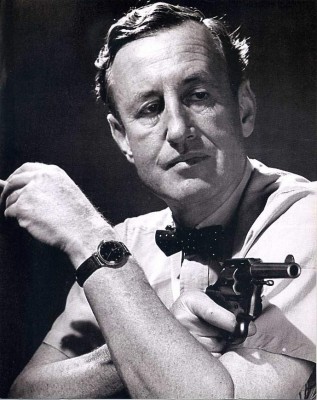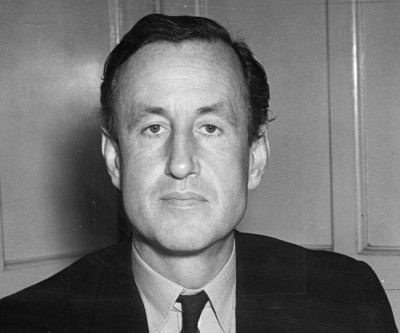
The name’s Blaize… John Blaize. This was the name that James Bond author Ian Fleming seriously considered giving to another of his creations, a dashing hero he developed for a possible film version of one of his non-fiction books, The Diamond Smugglers (1957).
The movie never happened, of course, but remains an intriguing aspect of Fleming’s various brushes with the world of TV and film-making, a pool he dipped his toe into on a number of occasions before the development of his highly successful relationship with EON Productions in 1961. The JBIFC takes the opportunity to briefly revisit the fascinating story behind The Diamond Smugglers.
Fleming’s non-Bond material
Both before, and ever since, Ian Fleming’s tragic and untimely death in 1964, there has been regular interest from various film-makers and TV producers in the Bond author’s non-fiction writings. Indeed, with the recent news that an American TV actor, Michael Weatherly, has been seriously looking at Ian Fleming’s travelogue Thrilling Cities (1963), it would seem such interest has revived yet again.
Weatherly, who is probably best known for his role as an investigative agent in the hit US TV series NCIS, revealed in May, 2016, that he had been exploring whether his production company, Solar Drive Productions, could possibly turn Fleming’s 1963 travel essays into a TV series. It is clear Weatherly is something of a Bond fan himself, and his role in NCIS has seen him make regular humorous references to the world of 007.
Unsurprisingly, such interest in Fleming’s writings was also arguably sparked up again when the James Bond author’s two non-fiction books were reprinted in brand new editions by Vintage Classics, and went on sale in the UK in early April, 2013. But it is interesting to recall how one of them, The Diamond Smugglers, nearly made it onto the big screen. For those readers unfamiliar with Fleming’s two main non-fiction works, the publishers Vintage aptly described The Diamond Smugglers (1957) as the ‘true story’ of an operation responsible for smuggling millions of pounds worth of precious gems out of West Africa, while Thrilling Cities (1963) was the product of Fleming’s commission from his employer The Sunday Times to explore some of the world’s most exotic cities, and view them through the eyes of an accomplished thriller-writer. The Bond author subsequently delivered a series of vivid snapshots of the hidden, and not so hidden, aspects of the major cites he explored. Both Diamond Smugglers and Thrilling Cities have evidently benefited from their association with the exciting world of Bond over the years, but not many people realise how the first book was nearly given a ‘Bondian’ screen makeover.
From Africa With Diamonds
Both books were very close to Fleming’s heart, but the first one, The Diamond Smugglers, clearly had some screen possibilities, even though this was not at the forefront of Fleming’s thinking when he initially commenced his investigative work for it. Fleming’s account of the true-life story of illegal gem dealing started life as one of his journalistic projects, a series of newspaper articles crafted for his employer in Fleet Street, the Sunday Times.
Sometimes real life has an uncanny habit of being stranger than fiction, and the James Bond author took a deep interest in the various forms of diamond smuggling that took place around the world. In the 1950s, Fleming was even briefed on the subject at De Beers, the famous diamond-selling company, by Sir Percy Sillitoe, the former head of MI5 (the British domestic Security Service). Sir Percy had taken a security job with De Beers and was head of a new private intelligence agency, IDSO (International Diamond Security Organisation). IDSO had been set up by De Beers to try to tackle the tremendous growth of the illegal side of the world’s diamond trade, and Fleming became more and more fascinated by the whole operation.
Fleming, of course, not only utilized the information he gathered from Sillitoe as useful authentic background information for his fourth James Bond novel Diamonds are Forever (1956), but much of the journalistic work he did on the subject (including various interviews) was also condensed into his series of newspaper articles. These articles, in turn, eventually became the basis for what became his first non-fiction book The Diamond Smugglers in 1957.
The Film that Nearly Was?
In March, 2010, Fleming’s former employer The Sunday Times offered some interesting new revelations on this aspect of the 007 author’s career. The newspaper carried a detailed 3-page article by author and James Bond expert Jeremy Duns, in which Duns sought to unravel what he called the ’50-year old mystery’ of a little-known screenplay that was specially written for a big movie version of The Diamond Smugglers.
Duns had discovered that, when IDSO closed down, Sir Percy Sillitoe felt that its work had not been sufficiently recognized. Sillitoe thus recruited one of IDSO’s former agents, John Collard, to ghost-write an account of the agency’s work. However, Collard’s treatment was deemed not sufficiently exciting by Denis Hamilton, the editor of The Sunday Times, so Hamilton persuaded Ian Fleming to use his professional writing and journalistic skills to ‘spice up’ and strengthen Collard’s story.
Fleming, in turn, rewrote the whole thing and, in the process, gave Collard the Bondish pseudonym ‘John Blaize’, making him the hero of the story. Blaize was, in a sense, a kind of ‘quieter’ version of James Bond, but this ‘JB’ still wore fine white silk shirts and was notably keen to gamble at the gaming tables in Monte Carlo! When the story was serialized in the newspaper in September, 1957, and finally published in book form as The Diamond Smugglers in November that same year, the film rights were quickly snapped up by the UK’s Rank Organisation, who apparently offered the then huge sum of £13,500 for the rights.
Rank, in turn, appears to have commissioned Fleming to ‘prepare the film treatment’. As so often happened in Fleming’s career, however, the film project seems to have stalled, possibly because the Bond author was reluctant to commit himself to all the script consultation meetings that would inevitably have taken place in England (Fleming regularly spent part of his year at his Jamaican retreat Goldeneye, working on his Bond stories). But what is particularly intriguing is that, at one stage, producer George Willoughby purchased the film rights from Rank, and then spent some time in the early 1960s trying to re-start the project. At one point, the actor Richard Todd was even down to play John Blaize. At another stage, Todd agreed to play the main villain instead, while rising American star Steve McQueen was penciled in as John Blaize.
As Duns speculated in his 2010 article, whether or not McQueen would have been interested in, or even available for, The Diamond Smugglers is another question, ‘but it’s fascinating to think of him as a secret agent in a Fleming adaptation’. Quite so.
Did You Know?
Ian Fleming was a master at generating publicity for his own books and articles, and often utilised his position on the Sunday Times to persuade his fellow journalists to help him in this marketing strategy. His investigative work on diamond smuggling was a classic example of this. In September, 1957, the newspaper reported that one of their star journalists, Mr. Ian Fleming, had been working on a top-secret project about the international diamond trade, an explosive series which would make ‘even his fiction plots seem almost dull by comparison’.

The James Bond author in the 1950s
